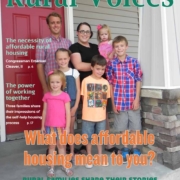Rural Poverty Rate Unchanged, Incomes Stagnant
Press Release
Contact: Lance George (202) 842-8600 x125
Dan Stern, (202) 842-8600 x137
Washington DC, Sep. 18, 2015 – Rural America, like the country as a whole, saw no improvement in poverty or income levels from 2013 to 2014, and a national rural housing organization called for increased attention to housing and economic needs.
“Stagnant incomes and poverty rates continue to hinder millions of rural Americans’ access to quality and affordable housing,” stated Moises Loza, Executive Director of the Housing Assistance Council, reacting to release of the U.S. Census Bureau’s annual report, Income and Poverty in the United States: 2014. “The economic recovery has not reached everyone. In fact, in some rural places poverty has persisted for decades.”
The Census Bureau calculates the national poverty rate at 14.8 percent for 2014, and the rate is higher in nonmetropolitan areas (16.5 percent) and central cities (18.9 percent). Through additional analysis of Census data, the Housing Assistance Council has identified more than 400 “persistent poverty” counties that are largely rural in nature. One visible sign of this economic distress is these areas’ poor housing conditions. Residents of the Mississippi Delta and the Southern Black Belt, Appalachia, Native American lands, and the colonias along the U.S.-Mexico border, as well as farmworkers, are more likely than others to live in decrepit homes and to pay high proportions of their incomes for housing.
The Census Bureau estimated the national household median income at $53,657 in 2014 and the rural median at $45,482. Overall, 8.24 million rural Americans lived below the poverty line in 2014. While those figures did not change significantly from 2013, Census did find a statistically significant decline in the number of people not covered by health insurance in 2014 compared to 2013. The national uninsured rate went from 13.3 percent in 2013 to 10.4 percent in 2014, and the rural rate fell from 12.8 percent in 2013 to 10.7 percent in 2014. The drop represents almost 700,000 rural people who were not insured in 2013 but are now.
A link to the Census Bureau report and additional information on rural poverty are available on HAC’s website at https://Ruralhome.org/sct-information/mn-hac-research/rrn/1227-rrn-poverty-estimates-2014.
About the Housing Assistance Council
Founded in 1971 and headquartered in Washington, D.C., the Housing Assistance Council is a national nonprofit corporation dedicated to helping local organizations build affordable homes in rural America by providing below-market financing, technical assistance, research, training, and information services. HAC’s programs focus on local solutions, empowerment, reduced dependency, and self-help strategies. HAC is an equal opportunity lender. To learn more about HAC’s programs visit www.ruralhome.org.


